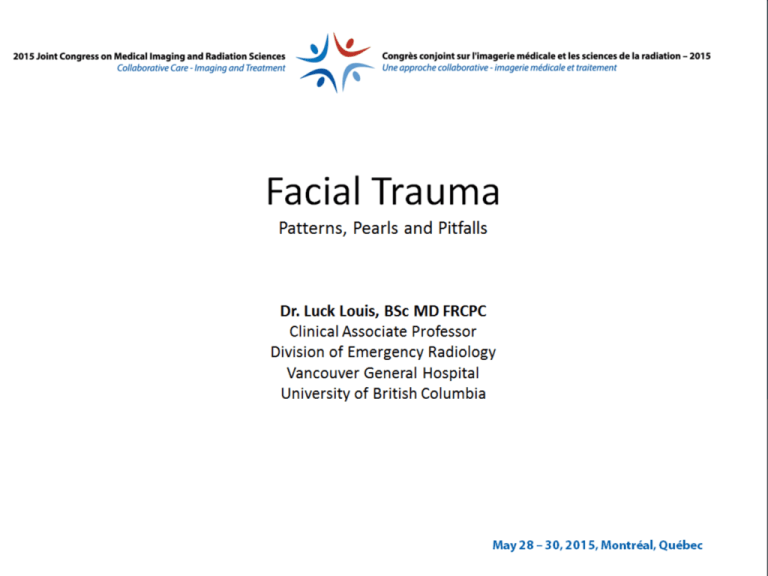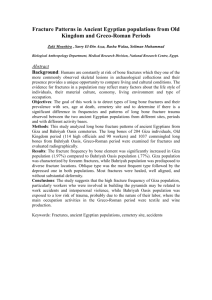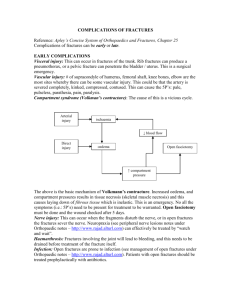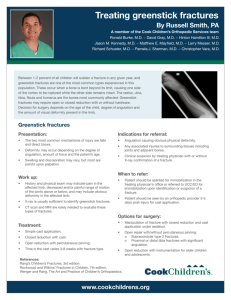(NOE) Fractures
advertisement

Themes Key landmarks Clinically relevant “Gotcha” injuries ○ Easy-to-miss, land you in trouble Simplify approaches to classification, where possible Differentiating one fracture pattern from another Of Processes and Terminology Of Processes and Terminology Frontal Bone Temporal Bone Maxillary Bone Of Processes and Terminology Frontal Bone Frontal process of zygomatic bone Temporal Bone Maxillary Bone Of Processes and Terminology Frontal Bone Zygomatic process of frontal bone Temporal Bone Maxillary Bone Of Processes and Terminology Frontal Bone Temporal Bone Maxillary Bone Maxillary process of zygomatic bone Of Processes and Terminology Frontal Bone Temporal Bone Maxillary Bone Zygomatic process of maxillary bone Clinical Relevance of Fracture Diagnosis Fracture repair timing Ideally <6-12h ○ Before onset of edema ○ Usually infeasible due to other injuries 3-7d post-injury ○ Edema begins to settle Early fixation (<10d) reduces errors from scar and callus Timely diagnosis is critical CT is critical because underlying deformity may be obscured by edema * Diagram and photo credits: www2.aofoundation.org and shenbagamhospital.org Classification of Facial Fractures Solitary Strut Isolated frontal or maxillary sinus wall Isolated zygomatic arch Nasal arch Isolated orbital floor, or medial wall or rim Complex Strut Naso-orbitoethmoidal, nasomaxillary Zygomaticomaxillary complex Transfacial LeFort I, II, III Mandibular * Modified from Kassell EE, Gruss JS: Neuroimaging Clin N Am 1:259, 1991 Frontal Sinus Fractures Direct blow to supraorbital region High force injury (>800 lbs) Anterior wall Forms the frontal bar Contributes to facial projection Foundation for vertical buttresses Posterior wall Separates sinus from cranial vault Projection Frontal Sinus Fractures Coronal CT: Frontal Mucocele Key landmark: nasofrontal duct Duct dysfunction may lead to mucocele formation Frontal sinus obliterated prophylactically Mucosa stripped and sinus packed with bone or fat Coronal CT: Normal Example Normal Duct 59F Normal 36M Facial injury ten years ago Nasal Bone Fracture Axial CT: Simple Nasal Bone Fracture Common 50% of all facial fractures Watch for: Septal hematoma ○ Saddle nose deformity Anterior nasal spine fracture ○ Chronic pain Involvement of medial orbital wall 61M Pedestrian struck Nasal Bone Fracture Axial CT: Paraseptal Hematoma Common 50% of all facial fractures Watch for: Septal hematoma ○ Saddle nose deformity Anterior nasal spine fracture ○ Chronic pain Involvement of medial orbital wall * Photo credit: http://images.rheumatology.org 22M Blunt trauma to face Saddle Nose* Nasal Bone Fracture 3D SSD: Anterior Nasal Spine Common 50% of all facial fractures Watch for: Septal hematoma ○ Saddle nose deformity Anterior nasal spine 31M Punch to face Lateral View: Anterior Spine Fracture fracture ○ Chronic pain Involvement of medial orbital wall 31M Drunk, fell Nasal Bone Fracture Common Axial CT: Naso-Orbital Ethmoidal Fracture 50% of all facial fractures Watch for: Septal hematoma ○ Saddle nose deformity Anterior nasal spine fracture ○ Chronic pain Involvement of medial orbital wall 66M Gunshot wound NOE Fractures Fractures involve: Nasal bones Frontal process of maxilla Medial canthal region Ethmoid sinus and walls Strongly associated with: Cribiform plate injury Intracranial injury Dural tears Nasal bone Globe injury Maxilla Lacrimal bone Orbital plate of ethmoid NOE Fracture Fractured nasal bones Associated open frontal sinus fracture Fractured medial wall Associated orbital roof blowout 61M Pedestrian struck NOE Fractures Key landmark: lacrimal fossa Medial canthal tendon inserts around fossa Formerly “ligament” Complex structure intimately related to orbicularis oculi Fracture may cause: Telecanthus Globe malposition Look for nasolacrimal duct to find the lacrimal fossa NOE Fractures Key landmark: lacrimal fossa Medial canthal tendon inserts around fossa Fracture may cause: Telecanthus Globe malposition Look for nasolacrimal duct to find the lacrimal fossa * Photo credit: Pham et al. “Computer Modeling and Intraoperative Navigation in Maxillofacial Surgery”. Otolaryngology 137(4): 624-631. NOE Fractures Coronal CT: Normal Lacrimal Fossa Key landmark: lacrimal fossa Medial canthal tendon inserts around fossa Fracture may cause: Telecanthus Globe malposition Coronal CT: Normal Nasolacrimal Duct Look for nasolacrimal duct to find the lacrimal fossa 59F Normal study NOE Fracture Classification Markowitz-Manson Classification: Type I ○ Fractured piece is large ○ Medial canthal tendon intact ○ Fixation of bony fragment restores canthal anatomy Type II ○ Comminution ○ Canthus tendon is attached to a small bone fragment Type III ○ Comminution with avulsion of medial canthal tendon ○ Cannot reliably differentiate from Type II on imaging * Hopper et al. Diagnosis of Midface Fractures with CT: What the Surgeon Needs to Know. Radiographics. 2006 May-Jun;26(3):783-93 NOE Fracture Classification Axial: Fractured Nasal Bones & Medial Walls 3D SSD: Manson Type I Coronal CT: Fractured Medial Wall and Floor Lacrimal Fossa Nasolacrimal Duct 38M Fell off bike onto face NOE Fracture Classification Markowitz-Manson Classification: Type I ○ Fractured piece is large ○ Medial canthal tendon intact ○ Fixation of bony fragment restores canthal anatomy Type II ○ Comminution ○ Canthus tendon is attached to a small bone fragment Type III ○ Comminution with avulsion of medial canthal tendon ○ Cannot reliably differentiate from Type II on imaging 3D SSD: Manson Type II 63F Massive blunt force trauma * Hopper et al. Diagnosis of Midface Fractures with CT: What the Surgeon Needs to Know. Radiographics. 2006 May-Jun;26(3):783-93 NOE Fracture Classification Markowitz-Manson Classification: Type I ○ Fractured piece is large ○ Medial canthal tendon intact ○ Fixation of bony fragment restores canthal anatomy Type II ○ Comminution ○ Canthus tendon is attached to a small bone fragment Type III ○ Comminution with avulsion of medial canthal tendon ○ Cannot reliably differentiate from Type II on imaging 3D SSD: Manson Type III 53M Gunshot wound * Hopper et al. Diagnosis of Midface Fractures with CT: What the Surgeon Needs to Know. Radiographics. 2006 May-Jun;26(3):783-93 NOE Fracture Classification • Always comment on: • The degree of comminution • Bilateral involvement • • • Nasofrontal ducts likely disrupted Risk of mucocele formation Frontal sinuses are surgically obliterated * Hopper et al. Diagnosis of Midface Fractures with CT: What the Surgeon Needs to Know. Radiographics. 2006 May-Jun;26(3):783-93 Zygoma “Cornerstone” bone Attachments to frontal, temporal, sphenoid bones of skull base Forms large portions of the orbital floor and lateral orbital wall Attachment to maxilla Contributes to projection, width & height Accurate diagnosis and reduction is crucial for: Restoring orbital volume Restoring facial projection, height, width Serving as reference for maxilla in Le Fort-type injuries Zygoma Fractures “Tripod” fractures Region of zygomaticofrontal suture Region of zygomaticotemporal suture Region of zygomaticomaxillary suture “Tetrapod” fractures Zygomaticosphenoid suture 3D SSD Often involves lateral maxillary wall Often the zygoma itself is intact Weaker bones and suture lines fracture around zygoma 24M Assaulted Zygoma Fractures “Tripod” fractures Region of zygomaticofrontal suture Region of zygomaticotemporal suture Region of zygomaticomaxillary suture “Tetrapod” fractures Zygomaticosphenoid suture Often involves lateral maxillary wall Often the zygoma itself is intact Weaker bones and suture lines fracture around zygoma “Tetrapod” SSD: Three of Four Attachments Disrupted 42M Punch to face SSD: Fourth Attachment Disrupted Zygoma Fractures “Tripod” fractures Region of zygomaticofrontal suture 3D SSD: Comminuted Zygomatic Body Region of zygomaticotemporal suture Region of zygomaticomaxillary suture “Tetrapod” fractures Zygomaticosphenoid suture Often involves lateral maxillary wall Often the zygoma itself is intact Weaker bones and suture lines fracture around zygoma 25M Car tire blew up in face Zygoma Fractures Preferred Term: Zygomaticomaxillary complex fracture Spectrum of zygomatic Injuries: Isolated zygomatic arch Tripod Tetrapod Amount of Force Comminution of zygoma ZMC Fracture Rotation around the zygomaticosphenoid suture is possible even if the upper transverse and lateral vertical maxillary buttresses are fixed Implications: Report suture disruption Review carefully on follow up imaging Transaxial CT: Zygomaticosphenoid Suture Disruption Le Fort Fractures Complex, multi-strut Dissociation of face from skull base at anchor points Universally involve: Nasal apparatus 1 2 Pterygoid processes Classic Le Fort injuries are uncommon Oversimplification but useful to communicate and to conceptualize injury * Picture credit: Rosario Van Tulpe under GNU Free Documentation License v1.2 3 Simplified Approach Fractured Structure Significance Pterygoid process Le Fort almost always present Lateral margin of nasal fossa Unique to Le Fort I Inferior orbital rim Unique to Le Fort II Zygomatic arch Unique to Le Fort III * Rhea and Novelline. How to Simplify the CT Diagnosis of Le Fort Fractures. AJR Am J Roentgenol. 2005 May; 184(5):1700-5 Simplified Approach Fractured Structure Significance Pterygoid process Le Fort almost always present Lateral margin of nasal fossa Unique to Le Fort I Inferior orbital rim Fractured Structure Zygomatic arch Unique to Le Fort II Significance Unique to Le Fort III Pterygoid process Coronal CT: Pterygoid Plate Fractures Le Fort almost always present Transaxial CT: Pterygoid Plate Fractures Lateral margin of nasal fossa Unique to Le Fort I Inferior orbital rim Unique to Le Fort II Zygomatic arch Unique to Le Fort III 63M Fall * Rhea and Novelline. How to Simplify the CT Diagnosis of Le Fort Fractures. AJR Am J Roentgenol. 2005 May; 184(5):1700-5 Simplified Approach Fractured Structure Significance Pterygoid process Le Fort almost always present Lateral margin of nasal fossa Unique to Le Fort I Inferior orbital rim Unique to Le Fort II Zygomatic arch Unique to Le Fort III Coronal CT: Pterygoid Plate Fracture Coronal CT: Nasal Fossa Fracture * Rhea and Novelline. How to Simplify the CT Diagnosis of Le Fort Fractures. AJR Am J Roentgenol. 2005 May; 184(5):1700-5 SSD: Le Fort I Simplified Approach Fractured Structure Significance Pterygoid process Le Fort almost always present Lateral margin of nasal fossa Unique to Le Fort I Inferior orbital rim Unique to Le Fort II Zygomatic arch Unique to Le Fort III Coronal CT: Pterygoid Plate Fractures Coronal CT: Inferior Orbital Rim Fracture * Rhea and Novelline. How to Simplify the CT Diagnosis of Le Fort Fractures. AJR Am J Roentgenol. 2005 May; 184(5):1700-5 Simplified Approach Fractured Structure Significance Pterygoid process Le Fort almost always present Lateral margin of nasal fossa Unique to Le Fort I Inferior orbital rim Unique to Le Fort II Zygomatic arch Unique to Le Fort III Coronal CT: Pterygoid Plate Fractures Coronal CT: Zygomatic Arch Fractures * Rhea and Novelline. How to Simplify the CT Diagnosis of Le Fort Fractures. AJR Am J Roentgenol. 2005 May; 184(5):1700-5 Le Fort Fractures: Pitfalls SSD: Unilateral Le Fort I & II Unilateral Requires a sagittal split of hard palate Results in widened maxillary arch Combined Le Fort types Same side Different sides Don’t stop searching Coronal: Left Pterygoid Plate Fracture Coronal: Palate Fracture 27M Post-op internal fixation Coronal: Nasal Fossa Fracture Le Fort Fractures: Pitfalls Unilateral Coronal CT: Fractures Lateral Nasal Fossa Walls Requires a sagittal split of hard palate Results in widened maxillary arch Combined Le Fort types Same side Different sides Don’t stop searching Axial CT: Fractures of Pterygoid Plates I I SSD: Fracture of Orbital Rim 61M Fall, head injury II Smash Fractures High energy fractures Severe comminution Multiple fracture planes Multiple fracture patterns Often associated with: 3D SSD: Facial Smash Intracranial injury Temporal bone fractures C-spine injury 66M Self-inflicted gunshot wound Elements of: Zygomaticomaxillary Complex Fracture 65M Attacked by grizzly bear Elements of: Naso-orbital Ethmoidal Fractures 65M Attacked by grizzly bear Elements of: Orbital Blow Out 65M Attacked by grizzly bear Elements of: Le Fort 65M Attacked by grizzly bear Landmark Significance Medial orbital wall in “simple” nasal fractures • Likely NOE complex fracture Nasofrontal duct • Dysfunction leads to mucoceles • May require frontal sinus obliteration Lacrimal fossa • Landmark for medial canthal tendon attachment Zygomaticosphenoid suture • Watch out for rotatory deformity Pterygoid plates Orbital soft tissues • • Marker for transfacial injury Next look at… lateral walls nasal fossa, inferior orbital rims, zygomatic arches • • Widen windows Look for foreign material








